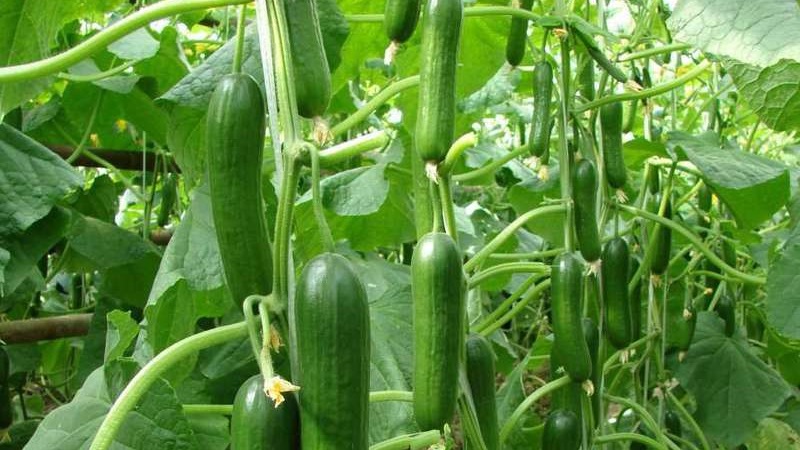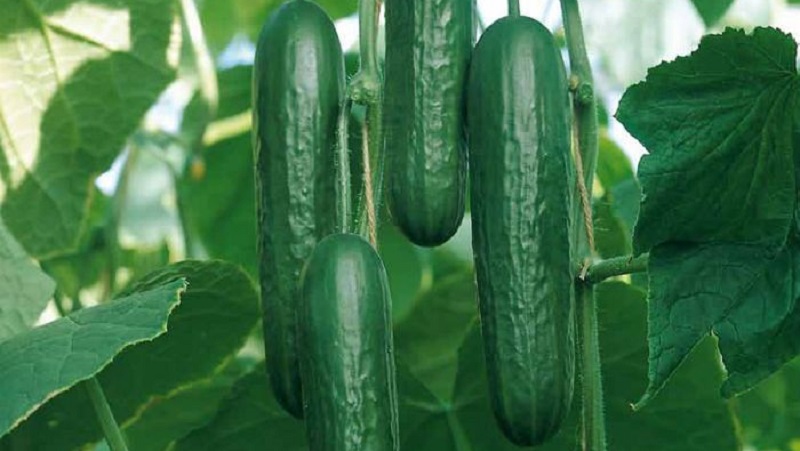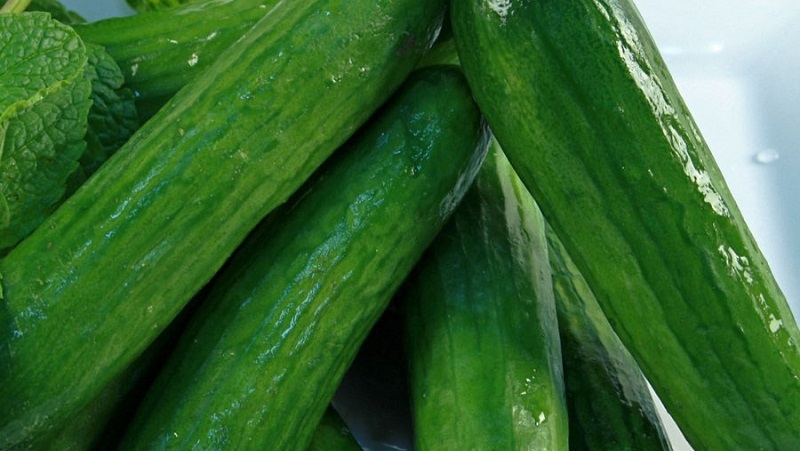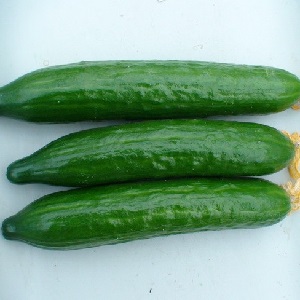Very tasty and productive Stella cucumbers: we get to know the variety and try to grow it ourselves
Cucumber is one of the ten most popular vegetables in the world. Since ancient times, people have known that it has beneficial properties for the body. The fruits of this culture contain about 80% of water, which improves the functioning of the kidneys and heart, has a beneficial effect on metabolism and appetite.
The cucumber came to us from the forest tropics of India. Therefore, to obtain a bountiful harvest, it is necessary to create conditions close to tropical conditions: constant heat and humidity. There is a wide variety of varieties and hybrids of cucumber. One of them is Stella F1.
The content of the article
Description of culture
Cucumber Stella F1 was brought out by domestic breeders from the All-Russian Research Institute of Vegetable Growing. It is recommended to grow the vegetable in the Central, Central Black Earth, North Caucasian, North-West, North, Volgo-Vyatka regions, as well as in the regions of the Middle Volga region.
Distinctive features
Stella F1 has good resistance to root rot, powdery mildew and ascochitosis. The fact that a vegetable belongs to hybrids makes the crop productive and hardy. The fruits of this plant have an excellent presentation. Cucumbers are grown both in greenhouse conditions and in the open field.
Composition, properties, benefits, calories
Since cucumber is mainly composed of structured water, it is an excellent thirst quencher. The vegetable contains a large amount of minerals and vitamins A, B1, B2, C, E, PP, N.
In addition, it includes:
- iodine;
- magnesium;
- sodium;
- phosphorus;
- potassium;
- carotene;
- calcium;
- glucose;
- fructose;
- starch.
The vegetable also contains coffee, ascorbic and folic acids.
Calorie content per 100 g of product is 15 kcal:
- proteins - 0.8;
- fats - 0.1;
- carbohydrates - 3.0.

Specifications
Stella has long whips, many side shoots and a high main stem. The flowering type is female. Leaves are green, large, heart-shaped. Fruit ovary is cylindrical in shape.
Stella F1 cucumber belongs to medium early hybrids. The first crop is harvested 65 days after germination.
The type of pollination is parthenocarpic, that is, the plant is pollinated independently, without the participation of insects.
From 1 sq. m. harvest up to 23 kg. Ripe vegetables have a corrugated base and an elongated cylindrical shape. The surface is grooved, slightly bumpy. Fruit length - from 20 to 25 cm, diameter - from 3.5 to 4.5 cm.One cucumber weighs about 270 g.
How to grow Stella cucumbers yourself
The soil for growing Stella F1 cucumbers should be light and rich in humus. Cucumbers are planted in the same place once every 5 years. This makes the culture more resistant to disease.
Cucumbers develop well in the place where tomatoes, potatoes, peas and corn used to grow. These vegetables are grown both by seedlings and by direct sowing into the ground.
Seed planting
Before sowing, they carefully prepare not only seeds, but also the soil. Since the cucumber sprouts well, most summer residents plant the seeds dry, but for complete confidence they are pre-treated.
The first step is to calibrate the seeds: even large seeds without dark spots are selected for planting. Then disinfect with the drug "Fitosporin", following the instructions on the package. Potassium permanganate is also used for processing grains. 1 g of potassium permanganate is stirred in 100 g of water. The seeds are placed in the solution for 20-30 minutes.
The next stage is germination. The grains are wrapped in a damp cotton cloth and placed in a container, which is wrapped with plastic wrap and removed to a warm place with an air temperature of + 22 ... + 26 ° C. The seeds are germinated within 1-2 days.
In regions with a cool climate, grains are hardened. To do this, the germinated seed material is placed in a damp cloth and placed in the refrigerator for 3-4 days, after which it is planted in the ground.
On a note. On sale there is seed that has already been processed by the manufacturer. This is indicated on the packaging. Such seeds do not require disinfection, they are sown dry.
Step-by-step instructions for planting seeds:
- Planting holes or even grooves are made and lightly watered with water.
- Grains are covered to a depth of 1.5-2 cm.If the soil is loose and sandy, a maximum of 3 cm.
- Dry seeds are planted at a distance of 5-10 cm. Germinated seed material is placed according to the scheme: 20-40 cm per 60-100 cm, 4-5 plants per 1 sq. m.
- Place 2-3 seeds in one hole. Subsequently, the weakest seedlings are removed.

Seedling planting
The seedling method yields a harvest 14 days earlier than direct sowing into the ground.
Before planting seedlings seed poured into a tissue bag and placed in a nutrient solution (1 tsp. nitrophosphate and wood ash are stirred in 1 liter of water) for 12 hours. At the end of the specified time, the seeds are washed several times with clean water, laid out on a damp gauze cloth and left for 2 days at a temperature of at least + 20 ° C. 24 hours before planting, the grains are placed in a refrigerator at a temperature of + 2 ... + 3 ° C.
Sowing seeds for seedlings is carried out throughout April. For this, use small containers up to 12 cm in height. The soil for these purposes is purchased in a specialized store or prepared independently.
To prepare the mixture you will need:
- 1 part small sawdust;
- 2 parts of humus;
- 2 parts of peat.
In 10 kg of the composition, 1.2 tbsp is mixed. l. nitrophosphate and 2 tbsp. l. wood ash. All this is thoroughly mixed and distributed in containers. 1 seed is planted in one pot with the prepared soil and slightly moistened. When two true leaves appear, the seedlings are ready to be transplanted to a permanent location.
Growing in stages and care
Stella cucumbers are watered systematically, but in moderation. Before flowering, the culture is moistened daily, and during the fruiting period - every 3 days. Water is used for this slightly warm.
For your information. Water the cucumbers in the morning or evening. In the daytime, moistening is not carried out, otherwise the leaves of the plants will receive sunburn.
For a good harvest of Stella F1 during the entire growing season, the culture is fed up to 5 times:
- During the appearance of the first full-fledged leaves, the first feeding is carried out with a mullein. The solution is prepared in proportions of 2 kg of manure per 10 liters of water. Mix well and infuse for 2 weeks. After that, the mullein is diluted with water in a ratio of 1 liter of fertilizer to 10 liters of water. Then add 30 g of superphosphate, 10 g of urea, 10 g of potassium sulfate.
- The second fertilizer is applied a week after the first. Add 1 tbsp to 10 liters of water. l. fertilizers "Agricola-5". Top dressing consumption: 3-4 liters per 1 sq. m.
- The third feeding is carried out 10 days after the previous one. Dissolve 2 tbsp in 10 liters of water. l. liquid fertilizer "Effekton-O". The culture is watered at the root at the rate of 3-4 liters per 1 sq. m.
- In 10 liters of water, dilute 1 tbsp. l. nitrophosphate and 2 tbsp. l. the drug Agricola Vegeta. For 1 sq. m consume 5 liters of the mixture.
- After 10 days, the fifth feeding is carried out. Add 2 tbsp to 10 liters of water. l. complex fertilizer "Agricola for Cucumbers". For 1 sq. m use 2.5-3 liters of the prepared mixture.
Features of cultivation and possible difficulties
The beds with the self-pollinating Stella F1 hybrid are systematically weeded. While the plants are still young, the soil is gently loosened, at the same time removing weeds. In the future, the procedure is repeated once a week.Timely harvesting is important for culture, since weighty fruits give a great load on plants.
Diseases and pests
Since the Stella cucumber belongs to hybrids, the crop has good disease resistance, but still there is little risk. In such cases, special preparations are used that protect plants from diseases and pests. When using funds, it is important to observe the dosage so as not to harm the culture.
The most common diseases include:
- White rot. This is a white, viscous consistency, due to which the fruits and the bush itself rot. The culture is treated by removing the affected parts of the plant and processing with a solution (for 2 liters of water, 10 g of urea, copper sulfate, zinc sulfate).
- Powdery mildew... The disease is manifested by the presence of white spots on the leaves, and later - on the rest of the plant. The leaves begin to dry out, fruiting stops. The affected parts are removed, and the bush itself is treated with fungicides (10 g of the drug per 5 l of water). If the disease has severely damaged the plant, it is destroyed.
- Downy mildew. The leaves are covered with small yellow spots and dry up. Subsequently, the disease spreads to the entire plant. Watering and feeding is stopped for 3-4 days, the plants are treated with "Polycarbacin" (10 g of the drug per 5 l of water).
- Cladosporium... Bushes and fruits are covered with brown sores. To combat the disease, stop moistening the culture for 5 days and treat the plants with "Fundazol" (10 g of the drug per 10 l of water). The infected parts of the bushes are removed.
On a note. It is necessary to fight the disease in the early stages of its development, otherwise the culture will die. There is also a risk of contamination of neighboring plants.
Often in the process of cultivation, pests also attack cucumbers. Mostly insects attack plants during the fruiting period.
The most common pests:
- Spider mite... It is located under the leaves, where it leaves its web. This parasite spreads various infections and eats foliage. In the fight against it, the reverse side of the leaves is sprayed with soapy water (200 g of grated laundry soap per 10 liters of water).
- Whitefly... It is a small white midge that sucks the sap from plants and leaves behind a sooty fungus and wilted foliage. In the fight against it, garlic infusion is used (200 g of grated garlic is stirred in 10 liters of water and allowed to brew for a day), which is sprayed on the whole plant.
- Aphid... These are small green bugs that settle on greenery in whole colonies and eat it, which leads to wilting of the leaves. The pest multiplies very quickly. Aphids are destroyed with an ash solution (200 g of wood ash and 100 g of soap are stirred in 10 l of water).
After identifying pests, they are destroyed immediately, since insects spread very quickly and move to neighboring plants.

Harvesting and application of the crop
It is very important for Stella F1 that the cucumbers are picked on time. If all ripe fruits are not harvested on time, the yield will decrease.
Cucumbers are harvested early in the morning. If this rule is observed, the harvest will increase. Plucked vegetables are immediately placed in the refrigerator, but not in closed plastic bags.
Cucumbers are great for making salads. They are rarely used for conservation, since the fruits reach 20-25 cm in length.
Advantages and disadvantages of the variety
Summer residents like Stella F1 cucumber due to the large number of positive qualities.
The benefits of this hybrid include:
 stable high yield;
stable high yield;- excellent taste;
- good presentation;
- the possibility of growing both in the open field and in the greenhouse.
- strong immunity;
- prolonged fruiting;
- self-pollination;
- good seed germination;
- transportability.
Culture has few drawbacks. These include:
- high demands on fertilizing;
- inability to use seeds from their harvest.
Stella has a lot of pluses.Against their background, minor flaws are invisible, which is why many vegetable growers prefer this particular hybrid.
Reviews
Experienced summer residents rate the Stella hybrid positively. Cucumbers are actively grown in the vast majority of regions of the country. The opinions of some vegetable growers are further in our article.
Mikhail, Cheboksary: “I have been growing hybrid cucumbers for 7 years in a row. Most of all I liked Stella F1. The plant is self-pollinated, which is good for growing crops in greenhouse conditions. The fruits really grow like the packaging with seeds in the photo - long and weighty, and most importantly - delicious. Last year I fed the plant, as they say, "from the heart", in the end there was so much harvest that I did not even know what to do with it. Probably, this hybrid is the right thing for implementation. "
Anna, Krasnodar: “From my own experience I have tried to grow many different hybrid cucumbers, until my neighbors advised me to Stella F1. Now for salads I plant only this cucumber, and always through seedlings... Fruiting is long, until the very frost. The vegetables are very tasty and have a thin skin. Even for the winter, I canned salads with the addition of these cucumbers. "
Conclusion
Stella hybrid has good resistance to diseases and negative factors. It has a high yield. The vegetable has an excellent presentation and tolerates transportation well. Leaving does not require much effort. Growing Stella is no different than growing all hybrid cucumbers. This vegetable has worked well among experienced vegetable growers, but is also suitable for beginners for the first vegetable growing.
For more information on the Stella F1 Hybrid, see the following video: